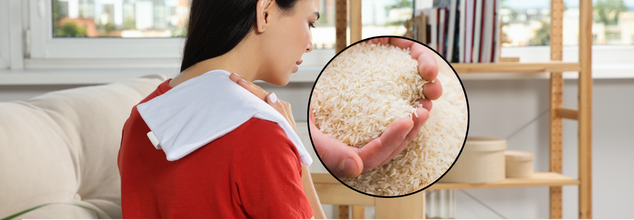- Health Conditions A-Z
- Health & Wellness
- Nutrition
- Fitness
- Health News
- Ayurveda
- Videos
- Medicine A-Z
- Parenting
- Web Stories
How To Make A DIY Rice Bag Heating Pad For Pain Relief In 3 Easy Steps

How To Make A DIY Rice Bag Heating Pad For Pain Relief In 3 Easy Steps
It was a cold winter evening, and I could feel the tension in my shoulders after a long day. My usual heating pad had quit, so I turned to a homemade solution: a rice bag heating pad. Surprisingly easy to make, it was also comforting and effective, providing just the relief I needed.
Why Use a Heating Pad?
Heating pads are known for their ability to reduce aches, ease joint stiffness, and soothe sore muscles. They work wonders for neck pain, back pain, menstrual cramps, and arthritis. Applying gentle heat to the affected area helps increase blood flow, which can reduce stiffness and encourage faster healing. Making your own rice bag heating pad at home is a quick, sustainable, and budget-friendly option for immediate pain relief.
How to Make a Rice Bag Heating Pad
Creating a heating pad requires only a few simple materials that you might already have at home. Here’s how you can make one with a sock and uncooked rice:
Materials
- An old, clean sock
- Uncooked rice (or alternatives like barley or oatmeal)
- Needle and thread (optional for extra security)
Instructions
1. Fill the Sock: Take your sock and fill it about three-quarters full with uncooked rice. Avoid overfilling, as you want it to be flexible enough to mold to different areas of your body.
2. Seal the End: Tie the sock tightly, or sew it shut if you want a more secure seal.
3. Heat It Up: Place the rice-filled sock in the microwave for 1–2 minutes. Carefully remove it, and test the temperature on your inner arm before applying it to your body.
For added versatility, you can also use this rice bag as a cold compress by storing it in the freezer.
How Heating Pads Work?
Applying heat, known as thermotherapy, to sore areas improves circulation, bringing oxygen-rich blood to aid in muscle relaxation and joint flexibility. Heating pads can be particularly effective for conditions like:
- Back and neck pain
- Menstrual cramps
- Migraine symptoms
- Arthritis and joint pain
Increased blood flow helps tissues heal faster by delivering more oxygen to damaged cells, which is essential in the recovery process.
6 Warning Signs In Your Mouth That May Point To Heart Problems

Credits: Canva
While your mouth and heart may seem unrelated, medical science shows otherwise. There’s a deeper connection between oral and cardiovascular health than most people realize. Certain dental symptoms can act as early warning signs for heart-related issues. To better understand this link, we spoke with Dr. SS Sibia, Cardiologist and Director at Sibia Medical Centre, Ludhiana.
When people think of heart disease, they typically focus on chest pain, breathlessness, or fatigue. But some of the earliest red flags can appear inside the mouth. Several oral health issues are directly linked to cardiovascular conditions. Research has long shown a connection between gum health and heart disease, and ignoring these subtle clues could lead to serious consequences.
6 Mouth Symptoms That May Be Warning Signs of Heart Disease
Here are six mouth symptoms that might point to an underlying heart condition:
1. Red, Swollen, or Bleeding Gums
Inflamed or bleeding gums often indicate gum disease (periodontitis), a bacterial infection of the tissues surrounding the teeth. Studies show that the bacteria responsible can enter the bloodstream, causing inflammation in blood vessels and contributing to artery blockages—a major factor in heart attacks.
Dr. Sibia explains: “Gum disease doesn’t just affect your mouth. It significantly raises the risk of cardiovascular complications. Persistent gum bleeding is a signal to visit both a dentist and a heart specialist.”
2. Wobbly Teeth or Tooth Loss
Losing teeth, particularly due to advanced gum disease, isn’t only about poor dental hygiene. It often reflects chronic inflammation in the body, which can increase the risk of heart attacks and strokes. Studies suggest people with fewer teeth due to gum infections are more likely to develop serious heart problems.
3. Persistent Bad Breath
Ongoing bad breath (halitosis) may be more than just a dental concern. It can result from bacteria linked to gum disease, which is strongly connected to heart health. Bad breath may also indicate inflammation or internal infection, both of which place additional strain on the heart if untreated.
4. Mouth Sores or Infections That Don’t Heal
Frequent oral ulcers or infections that take unusually long to heal could point to poor blood circulation or a weakened immune system. These issues are commonly seen in heart patients or people with diabetes, who are already at higher risk for cardiovascular disease.
5. Dry Mouth
A dry mouth (xerostomia) may be a side effect of medications for heart disease or high blood pressure. In some cases, it could signal dehydration, diabetes, or reduced blood flow, all of which can strain the heart. Dryness also makes the mouth more vulnerable to infections, indirectly affecting heart health.
6. Jaw Pain
Discomfort in the jaw, especially the lower jaw, can sometimes indicate an impending heart attack, particularly in women. This pain may radiate from the chest or neck and is often mistaken for a dental problem. If jaw pain comes with breathlessness, sweating, or chest tightness, seek medical help immediately.
Dr. Sibia warns: “Heart attacks don’t always start with chest pain. For some, especially women, symptoms like jaw pain or mouth discomfort may be the first signs. Detecting them early can be life-saving.”
Heart Disease: Mouth Symptoms
Regular dental visits, good oral hygiene, and attention to unusual changes can help detect potential heart issues early.
If you notice any of the signs above, don’t ignore them. Consult both a dentist and a cardiologist to ensure you’re not missing something serious. Timely check-ups, preventive care, and small lifestyle changes can significantly reduce your risk of heart disease.
Doctors Warn Of A Rare, Life-Threatening Condition Triggered By The Flu This Season

Credits: Canva
We all know influenza is a common and sometimes serious viral infection, but it’s worth a reminder as the flu season approaches, typically starting in October. Between October 2024 and May 2025, the United States saw an estimated 47 million to 82 million flu cases, leading to 610,000 to 1.3 million hospitalizations, according to preliminary data from the US Centers for Disease Control and Prevention. While most flu-related deaths occur in older adults, children can also be affected, with CDC estimates showing 37 to 199 deaths among children each flu season.
Now, a new study published in JAMA has highlighted a rare yet severe complication that can affect children who contract the flu. Known as acute necrotizing encephalopathy (ANE), this condition carries a mortality rate of 27% even with intensive medical care, according to the research.
What Is Acute Necrotizing Encephalopathy?
Acute necrotizing encephalopathy (ANE) is a rare but serious brain disorder that can develop after a viral infection, most commonly influenza. It begins with a fever and quickly progresses to severe neurological problems, such as seizures and a reduced level of consciousness. Importantly, the condition is caused by the body’s inflammatory immune response to the virus, rather than the virus directly attacking the brain.
Treatment typically involves supportive care and, in some cases, immunosuppressive therapies, but outcomes are often poor, with high rates of death and long-term brain damage.
Symptoms of Acute Necrotizing Encephalopathy
ANE usually starts with symptoms of the initial viral infection, such as fever, cough, vomiting, and diarrhea, followed by rapid neurological decline, which may include:
- Seizures
- Confusion, drowsiness, and altered consciousness
- Coma lasting for weeks
- Problems with movement (ataxia)
- Abnormal muscle tone
How Can Flu Lead to Acute Necrotizing Encephalopathy?
According to the National Institutes of Health, the flu can trigger ANE through an overactive inflammatory response. In this scenario, the body’s immune system, activated by the virus, ends up damaging brain tissue rather than the virus directly affecting the brain. This process, often called a cytokine storm, leads to rapid swelling, inflammation, and tissue death in areas such as the thalamus, resulting in severe neurological symptoms like seizures and coma. Genetic factors may also make some children more vulnerable.
The researchers collected data from US pediatric hospitals and public health agencies on cases of pediatric ANE treated between October 2023 and May 2025. They analyzed 41 children with influenza-related ANE. The median age was 5, and roughly three-quarters were previously healthy. Among those whose vaccination history was known, only 16% had received the flu vaccine that season.
All of these children became seriously ill, and every patient developed encephalopathy, meaning altered brain function. Sixty-eight percent experienced seizures, and most had abnormal platelet counts, liver enzyme levels, and spinal fluid composition.
The researchers emphasized a few key points:
- ANE is rare but extremely serious, with high risks of long-term illness or death, making early diagnosis and treatment critical.
- Most children affected were previously healthy.
- While a few vaccinated children also became ill, most cases and nearly all fatalities occurred in children who were not vaccinated that season.
Why the Flu Vaccine Matters
What is clear from this research is that getting the flu vaccine lowers the chance of catching the virus and of becoming seriously ill. The JAMA study also indicates that vaccination reduces the likelihood of developing ANE and the risk of dying from it. Both the study and an accompanying editorial stress the importance of everyone staying up-to-date with their flu shots.
As 2025’s Respiratory Virus Season Arrives, Here’s Your Guide To The Latest Vaccines

Credits: Canva
As the winter season sets in, the US Centers for Disease Control and Prevention (CDC) expects the 2025–26 fall and winter respiratory virus season to bring roughly the same number of hospitalizations linked to Covid-19, flu, and RSV as last year. Still, there are ways to lower your risk of becoming seriously ill from these infections, and vaccination remains one of the most effective measures.
According to preliminary CDC data from October 2024 through May 2025, around 1 million people were hospitalized with the flu last season, and there were as many as 130,000 flu-related deaths. Between October 2024 and September 2025, CDC estimates also show nearly 540,000 Covid-19 hospitalizations and up to 63,000 deaths due to the virus.
As the season of respiratory illness is here, let’s take a look at some common vaccine questions.
Who Can Get Covid Shots?
The CDC recommends that everyone aged 6 months and older, including pregnant individuals, discuss getting the updated Covid-19 vaccine with their health care provider this season. This marks a shift from earlier years, when the guidance broadly encouraged most people to get vaccinated.
“This fall, the CDC hasn’t issued a universal recommendation for the Covid-19 vaccine,” explained Dr. Dan Barouch, director of the Center for Virology and Vaccine Research at Beth Israel Deaconess Medical Center. “Instead, it’s being offered under a shared-decision model, where people are encouraged to talk to their doctor about the risks and benefits before deciding.”
When Is The Best Time To Get The Covid Vaccine?
Dr. Sarah Dupont, a family medicine physician at Emory Healthcare and assistant professor at Emory University School of Medicine, suggests getting the Covid-19 vaccine in October or early November for the best protection through winter.
How Effective Is The Covid Vaccine?
A recent study published in the New England Journal of Medicine found that last year’s updated Covid-19 vaccines were about 39% effective in preventing hospitalizations and 64% effective in preventing deaths among US veterans.
Who Can Get A Flu Shot This Year?
The CDC advises that most people aged 6 months and older should get a flu shot every year. Generally, one dose is sufficient each season. However, children receiving the flu vaccine for the first time should get two doses, spaced about four weeks apart, to build stronger immunity.
How Effective Is The Flu Shot?
The effectiveness of this year’s flu vaccine won’t be known until after the season ends. For reference, during the 2024–25 respiratory virus season, the CDC estimated that flu vaccines were 42% to 56% effective in adults.
Who Can Get An RSV Immunization?
RSV vaccines are recommended for adults aged 75 and older, and for those aged 50 to 74 who face a higher risk of severe illness, according to the CDC. A single dose can offer protection for at least two years in older adults.
To safeguard infants, protection can come either from maternal vaccination during pregnancy or from an antibody shot administered to the baby after birth.
When Is The RSV Vaccine Available?
Eligible adults can get the RSV vaccine at any point, though the CDC notes that late summer to early fall is ideal. For mothers, the vaccine is typically available from September through January, while infants can receive their antibody shot from October through March.
Beyond vaccination, there are other ways to stay healthy this season. Health experts urge people to stay home when they feel unwell to prevent spreading illness. Those who want to be extra cautious can avoid crowded indoor spaces during winter, and wearing a mask remains a personal option for reducing both your own risk and that of others.
© 2024 Bennett, Coleman & Company Limited

